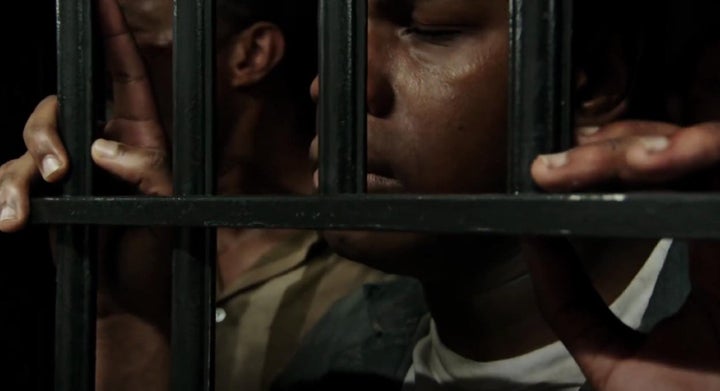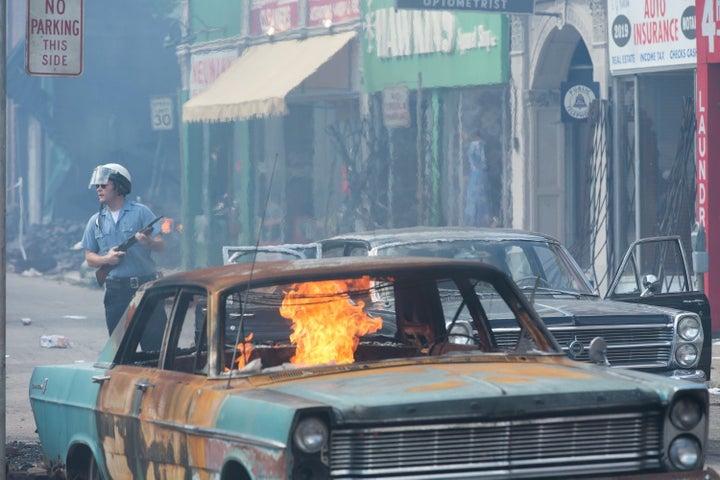
The church was packed. “Watch accurate justice administered by citizens of the community,” a flier announced. “Review and watch the evidence for yourself.”
Nearly two thousand black people and a smattering of whites crammed into Reverend Albert Cleage’s Central United Church of Christ on the evening of August 30, 1967. They were there to hold a people’s trial of the officers who had killed three young men at the Algiers Motel ― after the officers weren’t indicted and the media refused to press the issue. Young radicals, led by Dan Aldridge and Lonnie Peek, organized this “People’s Tribunal” on the suggestion of the Student Nonviolent Coordinating Committee Chair H. Rap Brown as a way “to bring out all the facts and the truth about what actually happened.”
The trial was held under an eighteen-foot image of the Black Madonna, installed by Cleage and painted by Detroit artist Glanton Dowdell in front of the church earlier that year so “we can conceive of the Son of God being born of a black woman.”
Those gathered heard the case against three white Detroit police officers, Ronald August, Robert Paille, and David Sendak, and a black security guard, Melvin Dismukes charged in what witnesses described as the “execution” of three young black men—Carl Cooper (17), Aubrey Pollard (19), and Fred Temple (18)—at the Manor House annex of the Algiers Motel on July 26, 1967, in the early morning of the fourth day of the uprising.
Attorney Milton R. Henry served as prosecutor; Solomon A. Plapkin, a white attorney, and Central Church member Russell L. Brown Jr. acted as defense counsel. Witnesses were kept out of sight until the final minute for fear of police intimidation and retaliation. Kenneth V. Cockrel Sr., a recent Wayne law school graduate and future cofounder of the League of Revolutionary Black Workers, was the judge. (The Detroit Bar Association considered disbarring the lawyers who participated in the trial.)
Witnesses vividly recounted the events. Rosa Parks, African American novelist John O. Killens, and black bookstore owner Edward Vaughn served on the jury. Journalists from France and Sweden covered the event. (Detroit reporters were there but not allowed to publish the story.) The jury found the officers guilty of murder. The reaction, according to Aldridge, following the convictions was “joy. … Because they heard the truth.”
“In Bigelow and Boal’s Detroit, there is no black activism before the uprising."”
Cinematic and powerful, the People’s Tribunal is film worthy. Yet it was completely left out of Kathryn Bigelow’s new film Detroit, written by Mark Boal, that opened nationally this weekend on the police killings at the Algiers Motel during the 1967 Detroit uprising. While black bodies play a starring role in the film, the stories and histories of black Detroit do not. Though heralded for its ‘research’, the film distorts and obscures the story of 1960s Detroit, the events at the Algiers Motel, and black life in the city more broadly.
In Bigelow and Boal’s Detroit, there is no black activism before the uprising. Yet in actual Detroit, there was a longstanding civil rights movement in the city focusing on housing and school segregation, job exclusion, and police brutality. Four years earlier, on June 23, 1963, nearly 200,000 black people marched through the city of Detroit—to highlight inequality in the city and that black people were no longer willing to tolerate business as usual. Thirteen days later, the police killed Cynthia Scott, shooting her once in the stomach and twice in the back. The officer wasn’t indicted. Young activists rose up in a wave of protests and picketing against police brutality.
While Bigelow and Boal’s Detroit contains many black people, it lacks a black community. Apart from a scene of the singing group Dramatics waiting to go on stage, we don’t see people having fun or with their families or really any aspect of black life in the city. The movie opens in an illegal after-hours bar but provides no context about it. That night people had gathered to celebrate the safe return of two men from Vietnam ― but the sense of joy and revelry is left out.
And in an act of resistance, when cops raided the bar at 4:00 am, patrons refused to disperse. This was a political act. Because many Detroit entertainment venues and restaurants during this time barred black people and black business owners had difficulty securing capital and acquiring permits for an official establishment, many working class black people socialized in these venues. Police regularly raided them ― and these raids had been a chief source of frustration before the uprising. July 23rd was the third time this establishment was raided in less than two years. People had reached their breaking point. But the movie doesn’t offer any of this. It is not long before we see a couple of black kids stealing a bicycle and then one throws a Molotov cocktail. Bigelow’s Detroiters are angry, alienated, unthinking and apolitical. The film cuts straight to mayhem and violence.

Like with this opening action scene, Boal fails to fully develop a coherent plot and background information ― particularly regarding key figures Cooper, Pollard, Temple, or security guard Dismukes. We never learn who they are as people, as family men, as lovers and partners, as workers or students or community members. Black lives are denied agency and stripped of their humanity.
In Bigelow and Boal’s Detroit, there is no larger structure of law enforcement that enables what went on at the Algiers Motel. The three cops are shown as bad apples not part of a broader system of policing. There is no sense of all the people in the police department and more broadly that allowed and countenanced what happened at the Algiers Motel. Indeed, many of the other cops in the film are shown either reprimanding Vauss (the leading racist cop) or trying to get out of their way. That Judge Frank Schemanske threw out the initial conspiracy charges against the officers is not even pictured.
Michigan Congressman John Conyers later described Detroit’s 1967 uprising as a “police riot.” But, because Boal and Bigelow are committed to the bad-apple storyline, this is also not shown in the movie. Police made thousands of arrests, most of which were baseless. Indeed, by spring of ’68, with half the 3200 looting cases cleared, 60 percent had resulted in dismissal and only two had resulted in convictions on the original charge. While numerous shots in the movie show the police headquarters and jails teaming with black bodies, it doesn’t convey that most of these arrests were illegitimate. The only black bookstore in Detroit, Vaughn’s Bookstore ― which had been the site of many meetings of black activists ― was firebombed by police, who ultimately left water running and ruined nearly all the books. That targeted attack on black community space is nowhere to be found in Bigelow and Boal’s Detroit.
Because there’s no people’s tribunal in the film, there’s no way to understand why there’s a trial, portrayed largely by dueling white lawyers, two years later. The film makes it seem like it happens naturally, instead of illustrating how black people in Detroit refused to let this incident get swept under the rug.
Given the focus on the film’s research, there is no way to understand these major omissions except that they are willful ― that to Bigelow and Boal, black community and political life matter little. black death is what is featured. The film is arrogantly titled “Detroit”—Bigelow says for marketing reasons—revealing their comfort in capitalizing on this view of the city and its black residents. The film normalizes black death; forty minutes of the film is devoted to scenes of the police tormenting these young men at the motel, in scenes which become almost pornographic in their length. And so ultimately what Bigelow and Boal offer viewers is a public lynching of black men. Overwrought with a deep fetishization of violence on black male bodies, it’s like watching a war zone in which black men are mangled, beaten, and objectified. Its excessiveness of violence and fascination with black male bodies eerily resembles D.W. Griffith’s 1915 film “Birth of a Nation” as racial stereotypes take center stage. Black people in the film are rendered largely as paper dolls ― angry rioters, bloodied victims, or sad relatives ― with little community, politics, work, joy, or even back story. The real-life implications of a movie like this are dire as black bodies are on full display murdered by police every day, yet the way the film handles this story reduces it to spectacle.
What makes this film not just sloppy but downright dangerous is that this very denial of black life, this blindness to the experiences and perspectives of black people, makes possible the kind of brutal and discriminatory law enforcement and the lack of accountability around it prevalent in the United States today.
If you want to see something that takes seriously the issue of police brutality against black people or the actual history of Detroit, don’t see this movie.
Jeanne Theoharis is Distinguished Professor of Political Science at Brooklyn College of CUNY. Her most recent book The Rebellious Life of Mrs. Rosa Parks won a 2014 NAACP Image Award. Her new book A More Beautiful and Terrible History: The Uses and Misuses of Civil Rights History will be out in January from Beacon Press.
Native Detroiter, Mary Phillips is Assistant Professor of Africana Studies at Lehman College, City University of New York. Currently she is working on a book manuscript, A Spirit on a Sword: Ericka Huggins’ Life as a Panther, Educator, and Activist, the first scholarly biography on a woman in the Black Panther Party.
Say Burgin is Assistant Professor of History at Dickinson College. She is currently working on an essay about Judge George Crockett, Jr. and his fight for equal justice under law in Detroit and around the country.